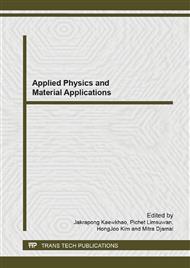p.181
p.185
p.189
p.193
p.197
p.201
p.205
p.209
p.213
Influence of Annealing Temperature on Microstructural and Optical Properties of TiN Thin Films Deposited by DC Reactive Magnetron Sputtering
Abstract:
Polycrystalline TiN thin films were deposited on silicon and quartz substrates by DC reactive magnetron sputtering technique. The as-prepared thin films were annealed in air at various temperatures ranging between 400 °C to 700 °C. The effect of annealing temperatures on the microstructural and optical properties have been investigated by field emission scanning electron microscope, Raman scattering spectroscopy and UVVis spectrophotometer, respectively. The raman results indicated the presence of the rutile TiO2 phase for the samples annealed above 500°C. Many hollow-spherical structures appeared on the surface of films annealed at about 600 °C and the hollow-spherical structures occurred increasingly as a function of annealing temperatures. In addition, the optical properties of thin films depended strongly on annealing temperature.
Info:
Periodical:
Pages:
197-200
Citation:
Online since:
September 2013
Authors:
Keywords:
Price:
Сopyright:
© 2013 Trans Tech Publications Ltd. All Rights Reserved
Share:
Citation:


